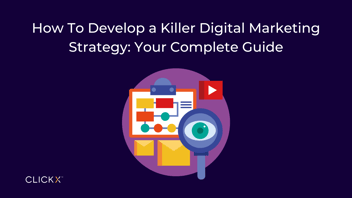4 Steps to Writing About Your Small Business (Without Sounding Like a Salesman)
When writing about your business, it can be a real challenge to create copy that doesn’t sound like a complete gimmick, particularly when you are adding this information to incorporate a call to action. Potential customers can easily spot anything that feels too much like an overt ad, and will likely skip it entirely.
It’s important to remember that any potential customer doesn’t have an intrinsic reason to care about your business, so you must give them one by making it about them and the problem they need solved.
In this post, you will learn several important steps you must take in order to sell your business in writing without sounding like a stereotypical sleazy salesman.
Step 1: Put the Focus on the Customer
Your customers are your business. It makes sense that to write about your business, you will write about the customer first and foremost.
Make sure that you have identified your customer’s needs, and talk about the pain points they experience that your business addresses in order to catch their eye. You can employ these pain points inside of blog posts, informative pages, and most of all, your company’s about page.
To achieve the desired effect, use less “we”, and more “you”. In other words, change the tonal direction towards the reader, rather than only providing a narrative of your own business.
To understand what that means, check out how Copyblogger does this by turning the message of the content towards you, even on their own company about page. Once they’ve cleared a bit about their history and credentials, they are already jumping right into how those credentials can benefit you.
When a reader is learning about your business, they’re looking for you to tell them: “Here’s what you can expect from us.”
[Tweet “When someone is learning about your business, express: “Here’s what you can expect from us.””]
Step 2: Be Honest About the Customer’s Options
Your potential customers are not stupid, and if they’ve found you online, they have access to the rest of the internet as well. They will find their options.
In order to build trust, you cannot neglect the fact that other options exist. However, this provides you with a unique opportunity to highlight what makes your option the best for their particular pain point. (See Step 4 to learn more about finding your unique selling proposition.)
For example, think of the Dollar Shave Club, who originally presented the question “Why waste time trying to remember to buy razors at the store, when you could pay only $1 per month and never worry about when to replace your razor again?”
This is a three point hitter:
- it presents their customer’s pain point,
- while acknowledging the alternatives, and
- incorporating the answer to why their solution is best.
You can imitate this concept by creating your own version of this same question. Fill in the brackets with your business’ information:
Why continue [the alternative], when you could [your solution], and relieve [customer pain point]?
When talking about the alternatives, do keep in mind that insulting the other options will not make you look any better. Your job is to make your selling point obvious compared to the competition by standing apart in a positive way.
Step 3: Write as if You Were Talking to Your Best Friend
It is all too easy to use overly-enthusiastic adjectives about your company that don’t add any value to your writing.
To help you curb this habit, pretend you are talking to one person, perhaps your best friend—or whoever knows you really well and will call you out on your self-glorification—as you write your content.
Your writing should show how you exemplify the adjectives you are so tempted to use. Don’t say that you have great customer service; show what makes your customer service great instead.
For example, rather than:
We have great customer service.
Try:
We put our customer’s needs first by answering inquiries within 24 hours and offering full refunds for any dissatisfaction. Even with our no questions asked refund policy, less than 1% of our customers ever request a return.
This will ensure that you maintain a no-fluff marketing policy, and that your content is accountable to reality.
Step 4: Talk About What Makes You Unique
There’s a popular saying in software documentation: “If the feature isn’t documented, the feature doesn’t exist.”
In other words, your customers are not psychic. You must discover what it is that makes your company unique and make sure that people know about it.
To continue with Dollar Shave Club as an example, selling razors is not unique. Millions of stores around America sell razors. However, when Dollar Shave Club launched, nobody was sending individual razors in the mail to their customers on a monthly basis. This made Dollar Shave Club unique.
What makes your business so unique may not be immediately obvious to you, but you need to find what it is. To learn more about doing this, learn how to discover your unique selling proposition.
Bonus Step: Offer Solutions, Not Products
Never forget that the customer doesn’t usually care about technical specifications, the product you sell, or the service you provide; they care about how it solves their problem.
A famous example is the way that Apple runs their marketing.
When the iPod arrived on the market, it was not the only way to listen to music on the go, but it stood apart in its messaging. Most competitors bragged about how many megabytes were available. The iPod simply said “1,000 songs”, using imagery that people could understand. People cared about how much of their music library they they could carry with them, not the technical details of why or how.
How does your solution solve a problem? Show how your product or service applies to the customer in a practical way.
You can read more about how to understand the way your products and services apply to your customers by reading this article about hiring milkshakes.
Conclusion
To avoid potential customers rolling their eyes at your self-promotion, you must learn how to write about your own business without sounding like a salesman.
In order to achieve this, you’ll need to:
- Put the focus on the customer and their needs
- Be honest about their options
- Use examples rather than adjectives for your business
- Be sure to highlight what makes your business unique
- Offer solutions for the customer that solve their problems
Taking these steps will lead to respectable copy that sells your business without sounding like a gimmick.
What have you found works for you when writing for your business? We’d love to hear your thoughts on what makes for good self-promotion! Share your opinions in the comment section so we can discuss your ideas to help you achieve your goals.







